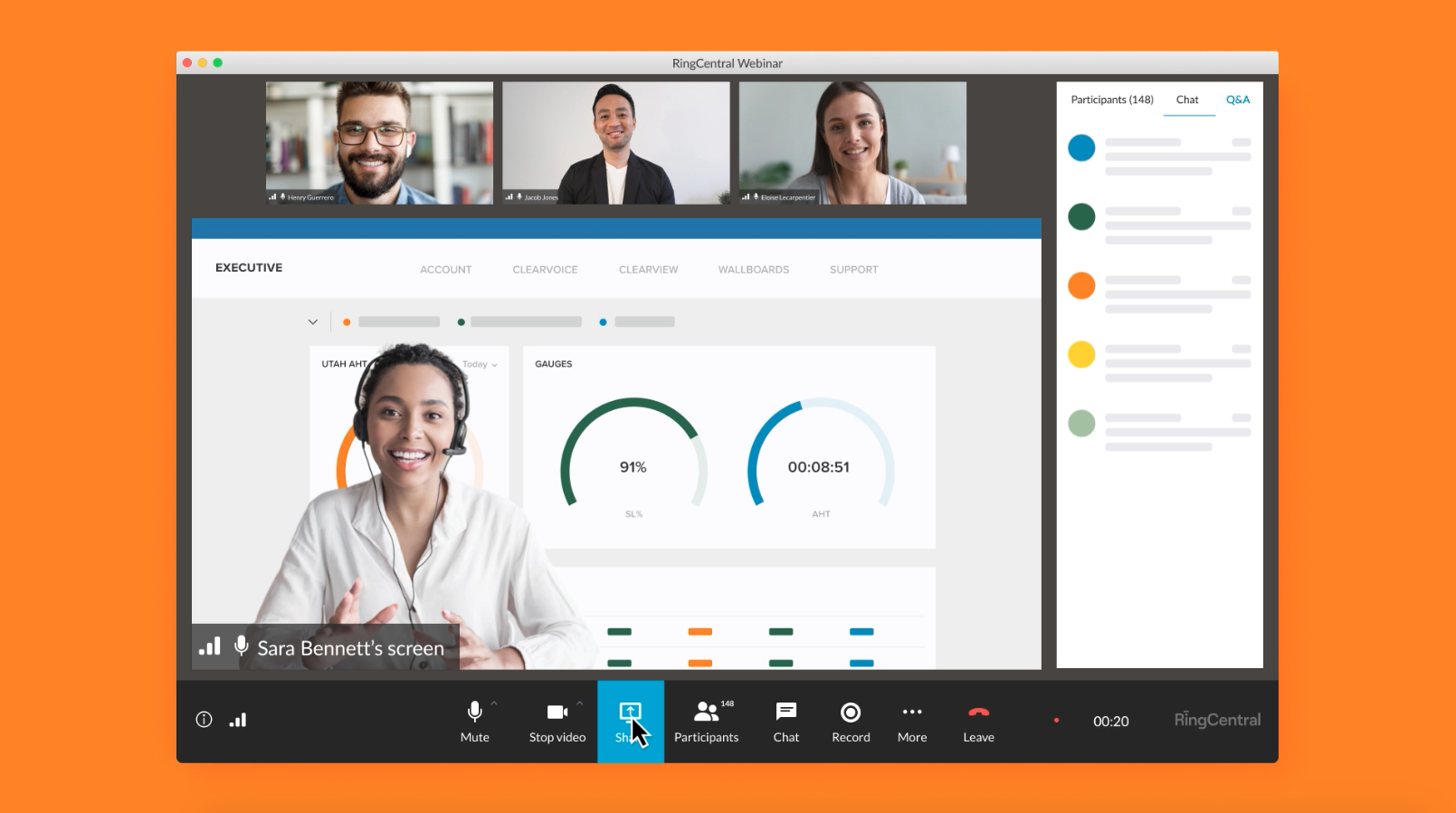Writing winning event proposals is akin to mastering an art form. So, picture your event proposal template as a blank canvas where you can create the piece of artwork everyone just has to see (and buy) at a gallery.
Not unlike paintings, the best event proposals can stop viewers in their tracks. And nailing these pitches can make or break event planners’, specialized service providers’, and agencies’ ability to win business.
Miss the mark and risk failing to capture viewers –– and losing the deal. But capture clients’ imaginations by painting a vision of how their events will come to life successfully and the engagement is yours.
Want your artistry and expertise to shine through in your event proposals and pitches? Follow these steps to outline and complete an event proposal template that will help you win over clients in 2022.
Paint-by-number event proposal templates aren’t effective
There’s no shortage of generic event proposal templates today’s event planners and agencies could use to try to win business. But, here’s the kicker: You don’t want to find your event proposal buried in your dream client’s email forest, looking almost identical to the rest, right?
At the end of the day, event planning proposal templates typically contain these core elements:
- Cover page and table of contents
- Client name and logo
- Event name, date, and description
- Event overview, experience, and objectives
- Your company’s name, logo, and overview
- Your team members’ resumés
- The event’s scope of work
- Event costs, budget, and timeline
- Contractual terms and signatures
So, if you’re seeking a tried-and-true way to beat out your competition, consider crafting your own event proposal template. 99% of marketers agree a personalized approach advances client relationships. When it comes to writing a winning event planning proposal, it pays to be different.
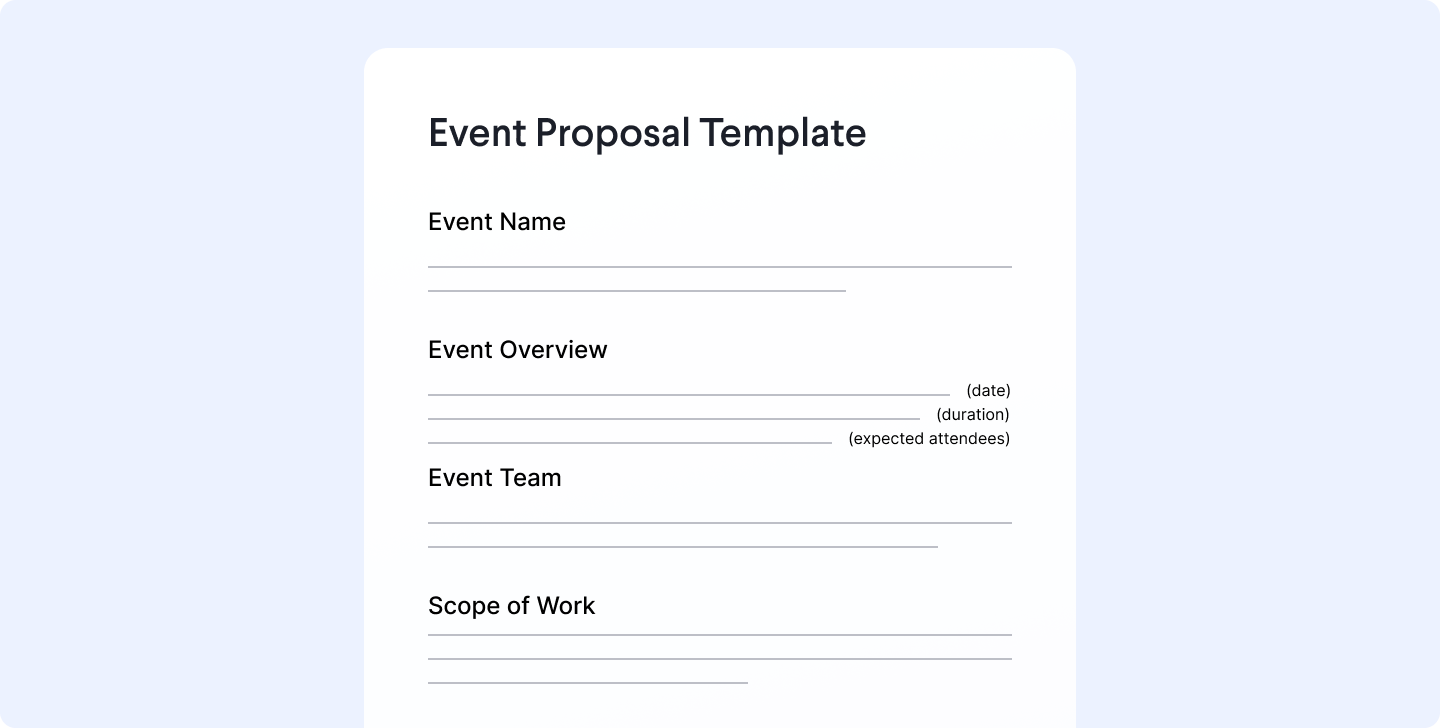
Stand out in the crowd
People retain 80% of what they see, so thinking visually is an easy way to get ahead. In fact, while people can typically process an image in about 13 milliseconds, the average person reads approximately 240 words per minute.
With that in mind, avoid a dense, text-heavy experience by creating an aesthetically pleasing event proposal that stops your ideal client in their tracks and saves them processing time. Consider tapping into these tactics:
- Employing graphic design: Incorporate attractive graphic design into your event proposal by trying your hand at easy, free, and DIY design tools like Canva. And if graphic design isn’t your forte, consider hiring a freelance graphic designer.
- Using visual layouts: Set your proposal’s tone with a striking design that uses strong visuals like logos, past client event photos, results, and statistics. Aim for skimmable copy and design elements, using catchy headers and images that reinforce value while telling a story.
- Including motion graphics: Go a step beyond static visuals with eye-catching motion graphics. Think about how things like videos, animated slideshows, and image carousels can attract and sustain attention while communicating and reinforcing key points.
While polished event proposals can catch your client’s attention, the true key to winning business is showcasing how well your mastery of event planning aligns with their event vision and goals.
With these tips and your experience, you already have the keys to success. Now, it’s just a matter of getting it down on paper. Follow these steps to create an event proposal template that wins you more business.
Step 1: Do your homework
People want to work with those who understand them and who they trust will deliver on their needs. In fact, 66% of customers say they expect companies to understand their needs and expectations.
So, kick off your event proposal process by taking the time to thoroughly research your client’s event, vision, business needs, and request for proposal (RFP). Ultimately, this will be crucial if you expect to win your client’s business because it will be the foundation of your event proposal.
Understand client audiences
All successful events have one thing in common: They put their audience first. So, make sure you can show how you’ll drive results by becoming an expert on your client’s audience –– their motivations, needs, and desires. Your research should include things like:
- The key characteristics of your client’s target audience
- Audience expectations around the value of attending your client’s event
- An in-depth understanding of how to attract, delight, and retain your client’s event community
Gather as much information as possible so you can figure out how to successfully connect your client’s event community with their event concept.
Evaluate the experience
Next, dig into how your client wants to bring their event concept to life and how they hope to engage their community.
Consider the experiential elements they’re likely thinking about, such as:
- How they hope the event will look and feel
- The emotions they seek to inspire in attendees
- What the event theme will convey and how it will elevate the experience
Focus on amassing knowledge around your client’s event vision and how it will benefit both their attendees and their bottom line.
Grasp the event goals
No one runs an event without a reason in mind. Events are usually a means to an end — that end often being business outcomes and results for event organizers.
So, seek to comprehend your client’s event goals by clarifying:
- Their vision of event success
- Measurable event outcomes they hope to attain
- The business needs they’re aiming to fulfill by running this event
- How they’ll measure return on investment (ROI) for the event
Build trust with potential clients and show them you understand their needs by outlining what you know about their business and doubling down on personalized details throughout your event proposal.
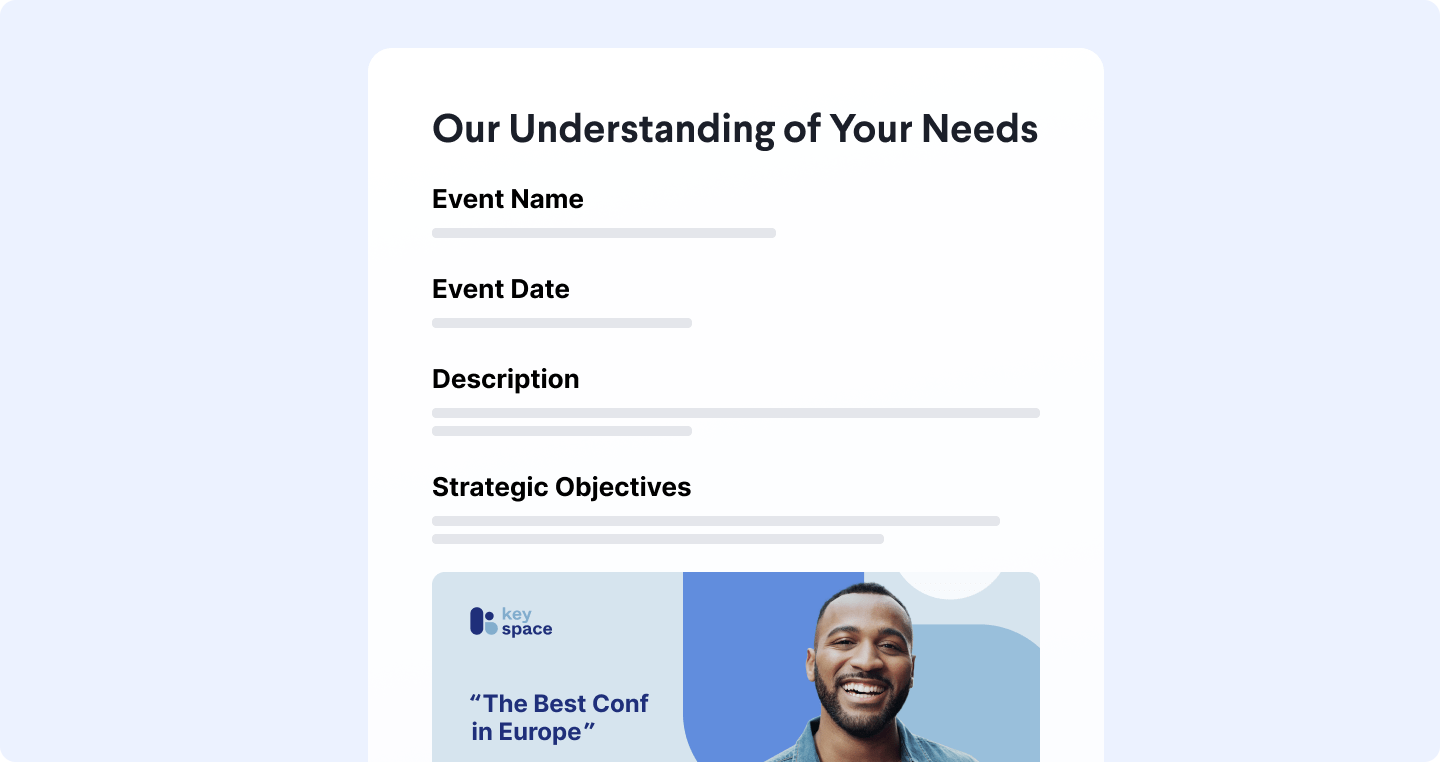
Step 2: Paint a clear picture of event success
Once you’ve demonstrated that you’ve done your homework and understand your potential client’s needs, show them how you’ll help pull off their event in a way that fulfills their vision and goals.
One way to help tip the scales in your favor? Use storytelling to elicit emotions and boost excitement. Position the client as the hero of this story and illustrate what they can achieve with your help –– and what they stand to lose if they don’t sign on the dotted line.
Use your research to inform how your event proposal will tell a story and consider these questions as you piece that story together:
- How does your client, the hero, benefit emotionally, socially, and practically?
- What challenges might they encounter? And how will you — acting as their guide — help them easily anticipate and overcome potential obstacles to achieving the success they desire?
- How will their event audience benefit as a result of your story? And how will your client feel rewarded as its hero?
Be evocative and build in some drama to show how you’ll bring their event to life and how they’ll benefit from your approach. That way, you’ll start to build an emotional connection with the client and it will become clear to them that you’re the one they want to partner with on their event.
Another pro tip for event proposal template success? When articulating your story, speak your client’s language. Default to their terminology. For example, if your client uses “mixed event” to describe a “hybrid event,” use “mixed event” in your proposal document. That way, your proposal will feel like a natural fit for them and you won’t inadvertently lose their attention in the process.
Finally, in this section of your event proposal, begin to subtly but purposefully express how incorporating your distinct approach to event planning will make their dream event come true. Give them a glimpse into how working with you will get them from point A to point B.
And, reassure them a talented crew will be there to support them every step of the way.
Step 3: Introduce your team’s expertise
Now, it’s time to describe how your team will make the client’s dream a reality. Keep your potential client’s event needs at the forefront as you begin to introduce the people behind your operation –– and the success you’ve achieved together.
Your team was handpicked because of their expertise, so share how they’ll work toward success and how that plays into the story you’ve sculpted above. Show, don’t tell — build trust and credibility by including work samples, logos of similar companies, and short case studies with customer testimonials from similar events your team has serviced.
Elevate your event proposal by highlighting the outcomes and results of prior customer events. Use visual examples to show how your team drove event results.
Here are some metrics that can help show how your team has driven results for past events:
- Attendee, sponsor, and client Net Promoter Scores (NPS)
- Ticket sales generated
- Total event registrations
- Attendance rates
- Sponsorship revenue secured
- Event ROI metrics
Help your potential client feel confident that you’ll drive success by highlighting your team’s event marketing expertise. Feature past event promotion wins across areas like:
- Event website traffic
- Email click-through rates
- Press coverage and media impressions
- Return on ad spend
- Cost of attendee acquisition
- Attendee lifetime value and retention
Don’t have these figures on hand? Don’t worry. Instead, aim to showcase examples of your creative event marketing strategies and tactics.
While numbers validate your ability to drive results, be sure to also give your event proposal a personal touch by including pictures of your team and tailoring their bios, expertise, and involvement in prior successful events to the task at hand.
Summarize why choosing your team will put the client on a path to success.
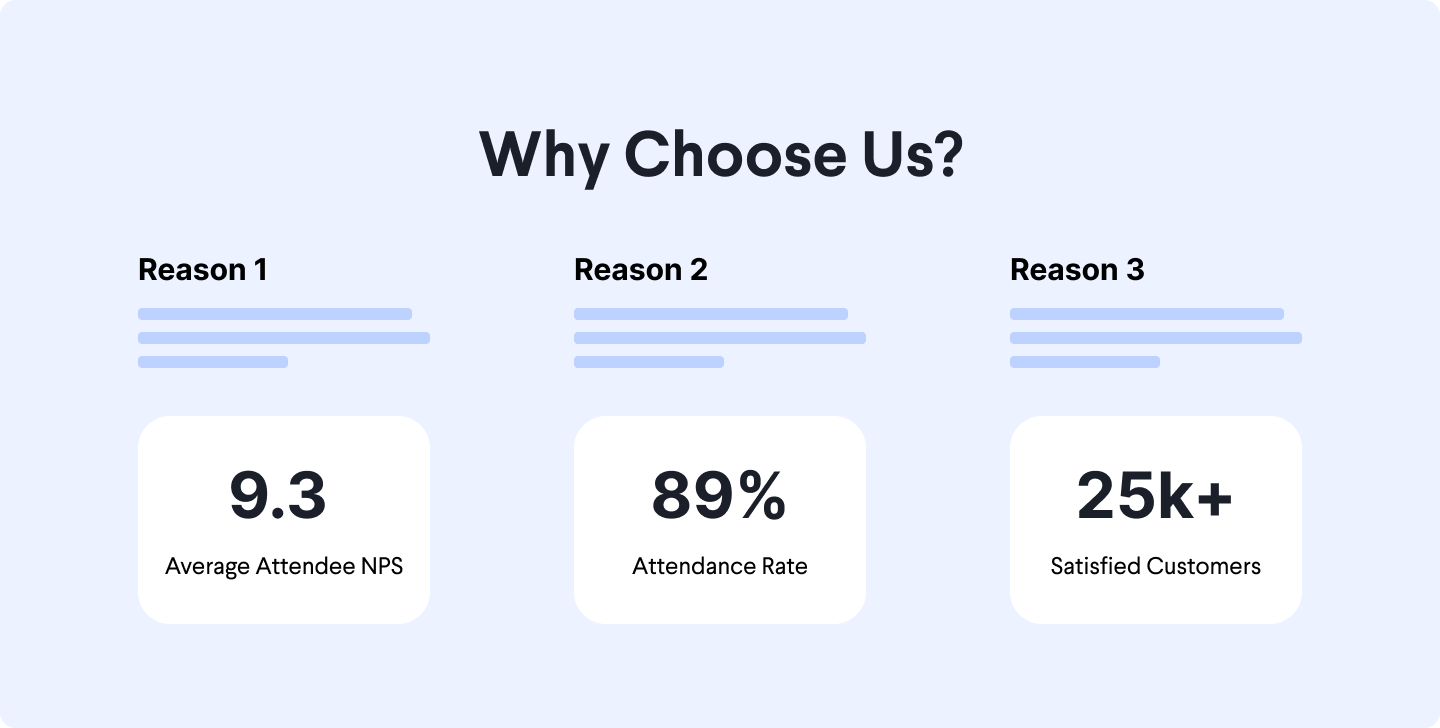
Step 4: Outline the details
At this point, your potential client will recognize what your team can bring to the table. Now it’s time to dive into proposed event details and logistics.
This is where you want to scope out the detailed event planning services you’ll provide.
Think about the following elements when outlining your proposed event services:
- Event experience development
- Venue selection, rentals, and design
- Event technology management
- Speaker sourcing and coordination
- Logistics, food and beverage, and experiential planning
- Management of vendor contracts
- Event marketing and website creation
- Registration and ticketing
- Staffing and attendee assistance
- Day-of live event coordination
- Contests, swag, or giveaways
- Sponsor procurement and liaison
- Audio-visual services, lighting, and technical support
- Graphic design, content, and signage
- Follow-up surveys and communications
The logistics and details you’ll scope will vary depending on your potential client’s event format. Remember to highlight why you’re proposing certain services and how those services will add value to the event.
Wondering how to connect your proposed scope of work back to event value drivers? Try mapping each element of this section back to the client’s vision, goals, and objectives for their event. And, give the client peace of mind by including an event timeline to help them understand you’ll deliver on time for every aspect of the event experience –– while being realistic about how long it takes to execute on each element.
A detailed event proposal that includes service offerings tailored to the client –– and your personal brand of magic –– will set you apart and clearly show the benefits of working with your team.
Why focus on client value in this section? Because next up is “the money part.”
Step 5: Show how you’ll deliver results
Ready to dive into the part of event proposals most people dread? Yes, now it’s time to talk about money. But, fear not. You’re about to learn how to master this part of the process.
The best way to position your financial section? You guessed it: by tying it back to client value. More specifically, look to align the costs within your event proposal to your client’s needs, desired impact, and event vision. Outline line items by breaking them down into separate sections for hard costs and service fees to show transparency and build trust.
Honesty is always the best policy –– be transparent about all costs and revenue streams. Conventional wisdom also says it never hurts to have options. This concept applies to your event proposal template, too. Instead of offering one rigid option in your budget proposal, consider including a high-end and low-end budget so your client can choose what works best for their needs.
Providing multiple budget options and a list of potential add-ons gives prospective clients flexibility, leaving plenty of room for your proposal to align with their pricing expectations –– and, in turn, generating more sales opportunities for you. Want an easy budget timesaver? Consider using an event budget template to document costs and revenue sources.
It also pays to think about how your pricing will be received. Get in front of potential pricing objections by adopting a salesperson’s mindset and putting yourself in the client’s shoes. Ask yourself: Are there any costs that may come as a surprise or be off-putting?
If so, address them head on. Explain why certain costs might be more expensive than others and why those costs could be worthwhile based on the benefits they could provide for the client and attendees.
With the financial piece of the puzzle in place, you’re now ready to close the deal.
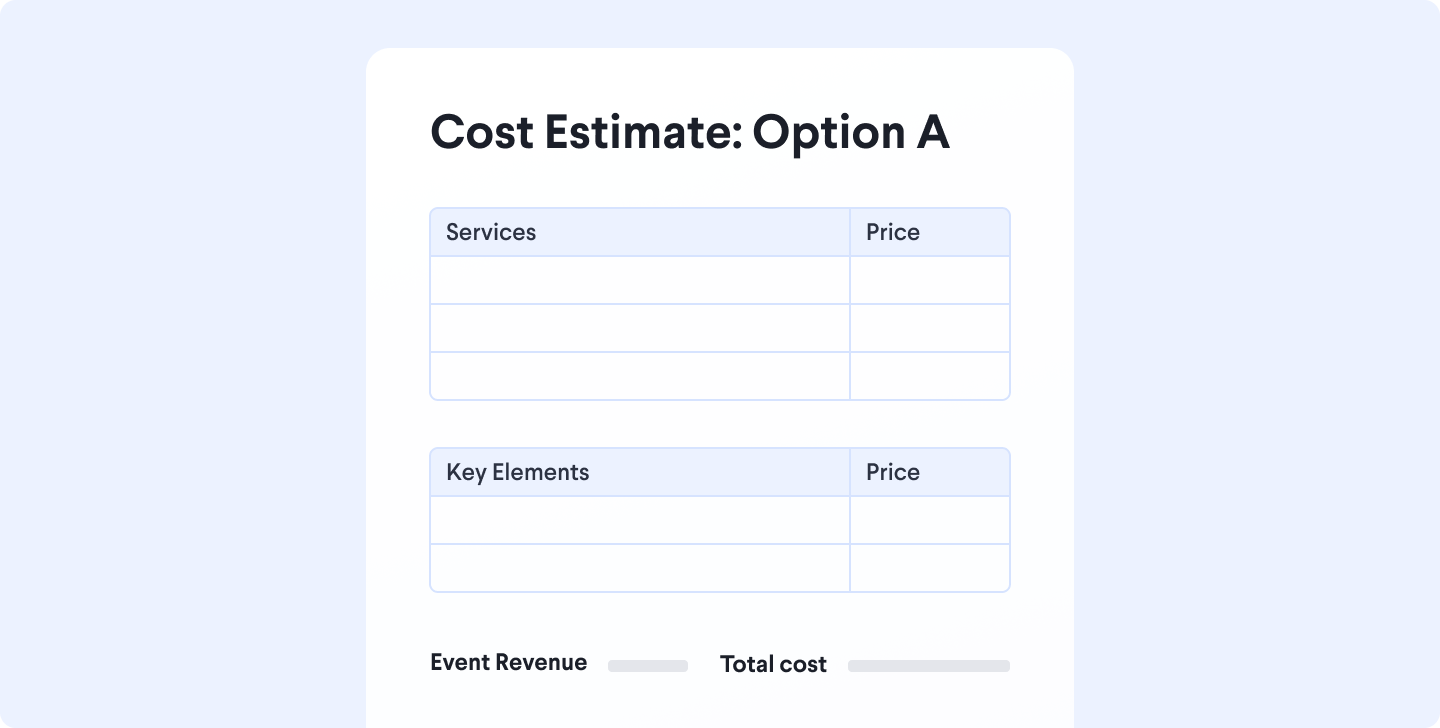
Step 6: Make it easy to sign on the dotted line
You’re so close to the finish line. Capitalize on the momentum you’ve built by wrapping up your event proposal with an easy way for clients to sign on and agree to your services.
Summarize the advantages of your approach and don’t forget to provide an avenue for questions and ongoing conversation.
You’re almost there. But before you hit send, gut check the proposal with your team to make sure they’re fully aligned, any errors have been caught, and the quality level is high.
While your client reviews proposals, schedule follow-up conversations and emails, if needed, to stay top of mind. Think about incorporating DocuSign to make it easy for clients to agree to your terms and sign on the dotted line –– electronically.
The advantage of streamlining your event proposal template and drafting process? You’ll make it easy for your potential clients to say “yes” to your proposed event planning services, and set yourself up to win new clients as well as repeat business.
Enhance your proposal with event technology
Your event proposal is the first impression your potential clients will have of you and your team. You want to make sure it stands out in a crowded market.
One more way to do this is by incorporating event technology into your pitch. Event management technology can help take an event strategy to the next level, and it’s something clients are increasingly asking for.
By highlighting the ways your team will use technology to enhance a client’s event, you’ll be sure to set yourself apart from the competition and show that you’re a trusted partner who understands what they need.
Let us show you how our team can use event management technology to take your proposals from good to great. Contact us today to get started.
Updated Mar 13, 2025









